Direct-to-consumer eCommerce (D2C): Why it still matters and tips for success

Direct-to-consumer eCommerce software giant Shopify made waves in July 2022 when they laid off 10% of their workforce due to “stagnating growth in the eCommerce space.” The post-pandemic return to traditional retail stores and inflation-related curbs in spending have been cited as causes of the slowdown.
But the reality is eCommerce still matters — a lot — whether it’s tied to a digitally native brand or a brand that also operates physical stores. eMarketer projects D2C eCommerce sales to hit 22% of total U.S. retail sales in 2025, up from 16% in 2022.
D2C companies can avoid stagnating by continuing to invest in online experiences that give their target audience a reason to keep coming back. If you don’t have a strategy in place to continually gather data and use it to build customer relationships, your D2C eCommerce experience is unlikely to drive brand loyalty.
Benefits of direct-to-consumer eCommerce
Cutting out any middlemen between you and the end customer might seem like a top benefit of direct-to-consumer eCommerce. But it’s the richer customer data, revenue potential, and ability to boost customer retention that make it ultimately worthwhile.
Collect more actionable customer data
As customers click on products and guides scattered throughout your online store, you get a bird’s-eye view of what interests them, even if they don’t purchase right away.
In traditional retail, it’s easy to determine which items are the most popular by looking at depletion reports. But you don’t know how many of your buyers are either new or have shopped with you for years. You also can’t be 100% sure how you attracted those new buyers.
eCommerce platforms such as Shopify keep track of such data and allow you to structure a more sound D2C marketing strategy.
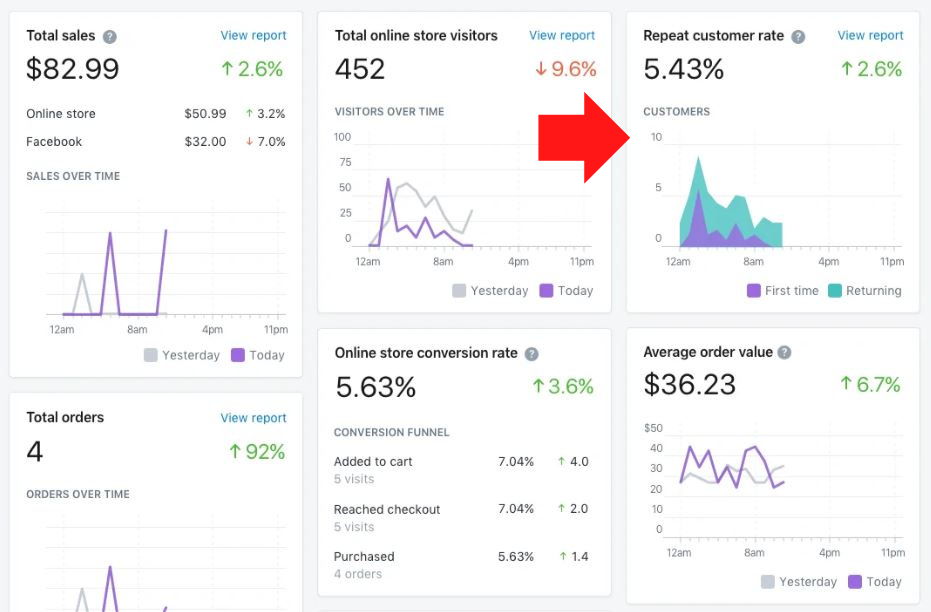
Image source. Sample Shopify analytics dashboard.
Now you can design welcome email campaigns for new buyers and thank-you campaigns for repeat buyers, each with their own incentives. The goal? Start building personalized relationships with each group that result in brand loyalty.
Higher average order values
Direct-to-consumer eCommerce often leads to higher average order values because you have more opportunities to digitally merchandise complementary products.
Physical stores use shelf talkers and impulse buys at checkout to increase AOV. But D2C eCommerce saves customers the trouble of walking two aisles over and searching for the item.
When a customer adds a product to their eCommerce shopping cart, use automation to trigger a pop-up to cross-sell a similar item prior to checkout. Just don’t get too eager with them. Pop-ups that appear eight seconds into a browsing session convert best, according to research from Drip, a marketing automation platform.
Wellness eCommerce brand The Honest Company uses bundling to increase average order values. When a customer clicks on a headband, Honest recommends kits that include it. With D2C eCommerce, customers immediately see the bundle’s value.
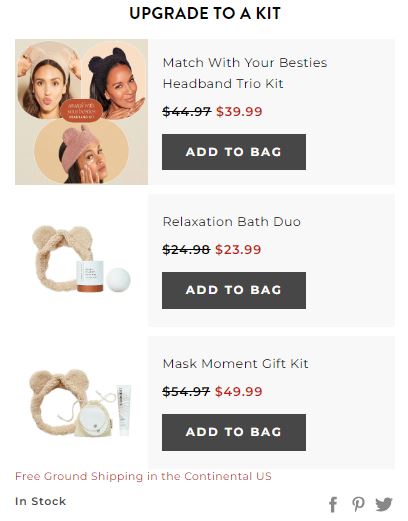
Image source. The Honest Company’s eCommerce bundling feature.
Even with the bundle discount, Honest is still generating more revenue than if the customer purchased the headband by itself.
Increased customer lifetime value
Because of the amount of data D2C eCommerce allows you to gather, you have a unique opportunity to increase customer lifetime value over time.
Customers keep buying from a brand if the experience and value it offers earn their continued support. According to a 2021 study from NTT, 22% of business owners said customer lifetime value was the “primary indicator” of a successful customer experience (CX).
With your trove of customer data and ability to gather feedback quickly and efficiently, you can keep customers engaged — and buying — as their needs and wants evolve.
For example, customers who place multiple orders each year for the same lipstick might be interested in a subscription experience. To confirm this theory, place a quick questionnaire at checkout or send them a post-purchase email asking if they would enroll in a subscription if offered. Shopify integrations such as POWR.io let you add survey forms or polls anywhere on your Shopify site.
By saving the customer the trouble of placing an order each time they run out of lipstick, you’ve improved their experience. Plus, you’ve increased the likelihood they’ll spend more over time.
Pillars of a successful D2C eCommerce strategy
You won’t realize the benefits of a D2C eCommerce business model unless you put personalization, convenience, and support at the center of your strategy.
Personalization
According to a 2021 McKinsey survey, 76% of customers get frustrated when they don’t get a personalized experience. This frustration can lead to higher rates of churn and lower customer lifetime value.
The fuel for personalization is the granular data that eCommerce platforms gather, as well as the information customers give you voluntarily. This information includes their email addresses, phone numbers, and survey responses. The trick is organizing and using this data in the right way.
Your eCommerce platform can help you identify your best customers, such as those with the highest spend and greatest purchase frequency. It can also alert you to customers who aren’t as engaged.
Then, you can adjust your marketing campaigns and messaging accordingly. At-risk customers might respond to pop-ups showing your best-selling items. Combine this tactic with “come back” SMS messaging and a limited-time discount on their next order.
Your best customers likely don’t need as aggressive a campaign. They may resonate more with an occasional email containing a “thank-you” message and discount on a product that relates to a previous purchase.
Convenience
eCommerce startups that make it inconvenient or difficult for customers to shop on their preferred sales channels, manage their orders, or return products will struggle to retain customers. Today, convenience in eCommerce means creating seamless buying experiences wherever and however your customers wish to shop and engage with your brand.
Social commerce — or buying via social media platforms — is expected to cross the $6.2 trillion mark in 2030, according to Grand View Research. Shopify now integrates with TikTok, allowing customers to shop from that platform. Businesses can then manage those orders from within Shopify itself.
Another convenience trend you can’t ignore (if you maintain physical stores) is buying online and picking up in-store. Research and Markets forecasts this phenomenon to grow by a rate of 19% each year between now and 2027.
The ShipperHQ app gives customers this option alongside standard shipping. It integrates with major eCommerce platforms, including WooCommerce, Salesforce, BigCommerce, and Shopify.
Customer support
A direct-to-consumer eCommerce strategy must also encompass post-purchase customer needs, especially customer support. A negative support experience can drive away customers who’ve otherwise had a seamless eCommerce experience.
According to Zendesk, 81% of customers say “a positive customer service experience increases the likelihood they’ll make another purchase.”
eCommerce customers should be able to find answers and solve problems as easily as asking a store associate in traditional retail.
Gorgias, a support platform that integrates with Shopify, conveniently allows customers to ask a support question via live chat, social media, and other digital channels. Better yet, agents can see customers’ support and order history and make changes in Shopify itself. This approach saves the customer time.
5 best practices for D2C brands
Once you have your D2C strategic framework in place, following a few best practices will ensure that your eCommerce experience remains customer centric.
1. Map out the customer journey
Customer journey mapping helps you visualize what your personalized and convenient D2C experience looks like in practice. Unless you plan each experience carefully, you risk creating friction when you implement them.
When a customer joins your SMS list or abandons their shopping cart, what steps will you take in each situation to move them deeper into the sales funnel? Enter mapping.
Tools such as UXPressia let you create “digital whiteboards” of customer journeys. Create as many maps as you need and share them easily with key stakeholders.
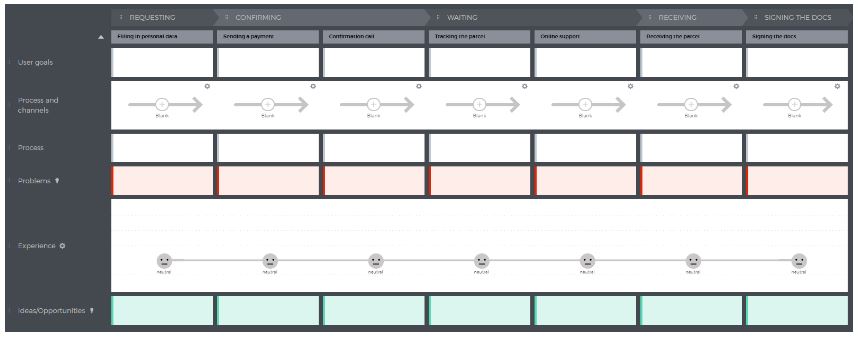
Image source. UXPressia’s digital customer journey map template.
Say you want to launch an eCommerce subscription experience. Name each column header with each stage in the subscription experience, such as “Signing Up,” “Waiting for Shipment,” and “Receipt of Shipment.”
The first row can list customer emotions or expectations at each stage. The following rows can list how you plan to meet those expectations. For example, customers likely experience anticipation at the “Waiting for Shipment” stage. Your response could be to send an email or SMS message three days before the shipment goes out, giving them the chance to postpone it, if necessary.
2. Choose your eCommerce platform carefully
You can’t implement your journey map without the right eCommerce platform. Your platform choice also controls how quickly you can scale your business and respond to changes in customer behavior.
While you need to consider platform cost, there are at least three other key questions to ask during the vetting process.
- Does the platform integrate easily with third-party providers? eCommerce platforms are your customer-facing storefronts. They need to interact seamlessly with other logistics, shipping, and marketing automation platforms containing data that control the customer experience. If you outsource fulfillment to a third-party logistics provider like ShipBob, make sure your eCommerce platform syncs with its inventory management software.
- Does the platform make it easy to A/B test elements of the customer experience? You may have set up your store according to your mapped journeys, but is your setup driving expected conversions? Shopify has an app called Lomio that lets you A/B test elements that may be causing friction. Using Lomio, test product descriptions, colors, and even website themes.
- How available is customer support? If your shopping cart encounters a glitch during a new product release, you’ll want to talk to support yesterday. Phone support often incurs additional fees, so make sure you understand their policy before signing the dotted line.
3. Include a subscription experience
Subscriptions are direct-to-consumer models that help give customers the personalized and convenient eCommerce experiences they seek.
The convenience comes from recurring shipments of desired products. It also comes from giving subscribers control over their shipping cadence, such as skipping or pausing orders when necessary. We’ve also learned that subscribers last 71% longer when they can swap items in and out of scheduled shipments.
With convenience comes longer subscription enrollments. The longer subscribers stay in the fold, the more data you can gather, and the more personalized your communications and offers become.
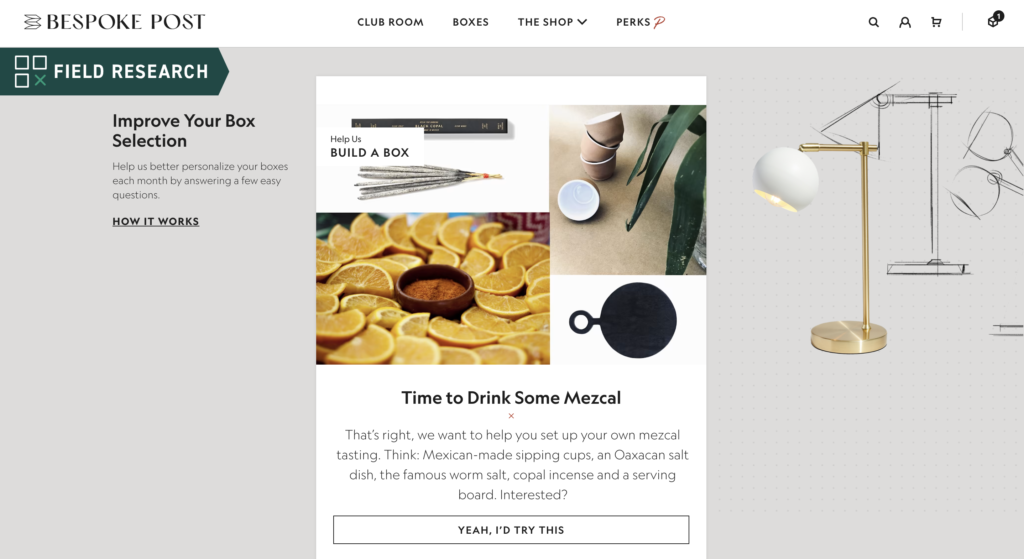
Image source: Private account. Bespoke Post’s personalized subscription boxes.
eCommerce subscription platforms such as Ordergroove easily integrate with popular eCommerce platforms, giving customers seamless purchase experiences without hijacked checkouts. These checkouts occur when customers leave your branded shopping cart for another platform where payment occurs.
Our data shows that hijacked checkouts can lower subscription enrollment by as much as 40%.
4. Create a loyalty program to encourage retention
Loyalty programs give eCommerce subscribers and nonsubscribers alike a reason to stick around because they reward repeat purchases and other types of brand engagement. These rewards can include discounts or access to experiences reserved for loyalty members.
Many brands charge a fee to enroll in their loyalty programs, which actually leads to higher spend overall. A 2020 McKinsey survey found that members of paid loyalty programs are 60% more likely to spend more after enrolling. Members of free programs are only 30% more likely to spend more.
Loyalty programs are rarely native to eCommerce platforms. You’ll need plugins like Yotpo to create a tiered program based on points, spend, purchases, or referrals. Points are a popular option, and Yotpo lets you award them when customers leave reviews, like your Facebook page, or hit a spend threshold.
A critical success factor is making it easy for customers to understand the program rules and redeem points.
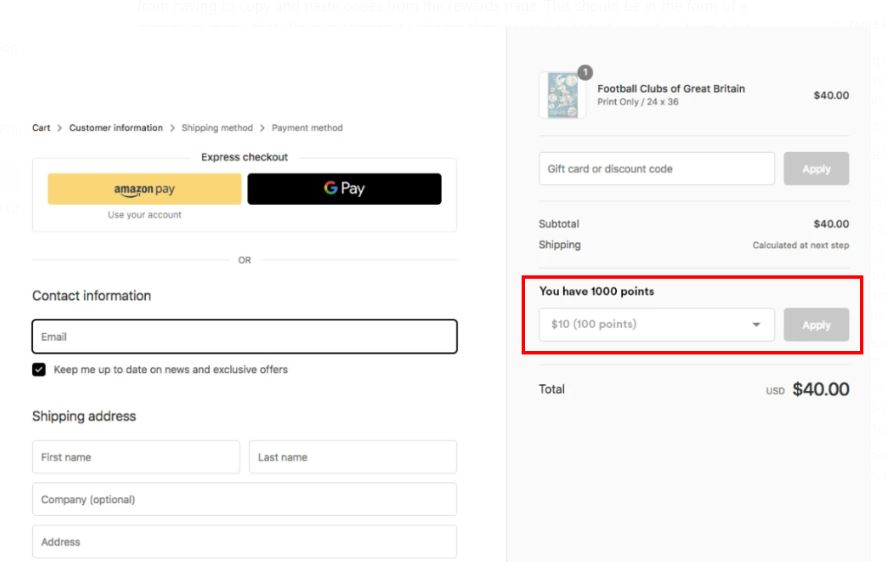
Image source. Yotpo’s loyalty program eCommerce integration.
Yotpo’s eCommerce platform integrations let customers see their point total and redeem them at the moment of checkout.
5. Evaluate success metrics on a regular basis
Without specific success metrics and KPIs, you won’t know if the journey you’ve mapped and the strategy you’ve created is leading to genuine business growth.
Here are three you should check the most often. Keep in mind that success looks different depending on your industry vertical. The point is that when your numbers dip below established benchmarks, there are concrete things you can do to turn things around.
Average order value. This metric is a window into a customer’s buying behavior, which can change over time. When it starts to dip, it means you need to look for new ways to increase a customer’s number of shopping cart items.
Say you already offer bundles of five products each. Perhaps new customers now have a hard time committing to buying five products up front, even at a discount.
Leave the bundles alone, and try adding a threshold feature where you show customers while they shop how many products they need to buy to get free shipping. Perhaps it only takes three products, which is less of a commitment.
Customer lifetime value. Your most loyal customers have the highest lifetime value. A drop in this number can be the result of many factors, so sometimes, it’s best to ask these folks what you can do better.
If you use a customer experience tool like Medallia, send your top customers a brief Net Promoter Score survey. Ask them how likely they are to recommend your eCommerce store. Include an open-ended question so customers who are unlikely to recommend you can leave a reason why.
This metric is doubly important because the more you can increase CLV, the less you need to spend on customer acquisition costs.
Repeat purchase rate. It’s not cheap acquiring a customer, which is why you want to ensure they buy again. Offering a subscription experience is one of the best ways to improve this metric, but another is reexamining how you bring customers back to your eCommerce site.
If you only push offers and content with email, try adding SMS messaging to reach a younger demographic. SMS platform Attentive integrates with Shopify, so you can send offers that reference customers’ previous orders.
3 D2C eCommerce brands that truly understand their customers
The most successful direct-to-consumer brands understand what engages their customers and motivates them to buy. While understanding the customer is always a work in progress, here are three d2c subscription brands keeping pace with that evolution.
1. Birchbox: Give customers more control over their experience
Pioneering eCommerce beauty brand Birchbox quickly realized they had to innovate once their success spawned a number of competitors. One way they differentiated themselves was by giving customers more customization options, flexibility, and control over their shipments.
Birchbox introduced a questionnaire designed to help them personalize their boxes with unique products. After completing the quiz, shoppers are given a list of recommended sample and full-size products that meet their needs. From here, subscribers can customize their subscription box, or they can let Birchbox do the work for them.
Now, Birchbox doesn’t risk sending their subscribers products that they don’t want or can’t use. This drives a level of personalization that other subscription boxes struggle to compete with.
What’s more, Birchbox gave their subscribers more control over their subscription box. The brand’s subscribers can skip an order if they need a break, and they can swap out multiple smaller products for a single, more expensive item.
2. KIND Snacks: Incentivize subscriptions
KIND Snacks understands the end consumer wants value as much as convenience and personalization when they shop online. They position their subscriptions as providing all three, incentivizing customers to become subscribers.
At the eCommerce point of purchase, KIND Snacks shows customers what they stand to save by subscribing as opposed to buying once. A 2021 McKinsey survey showed that 62% of new subscribers cited “the right combination of offerings and pricing” as a reason for enrolling.
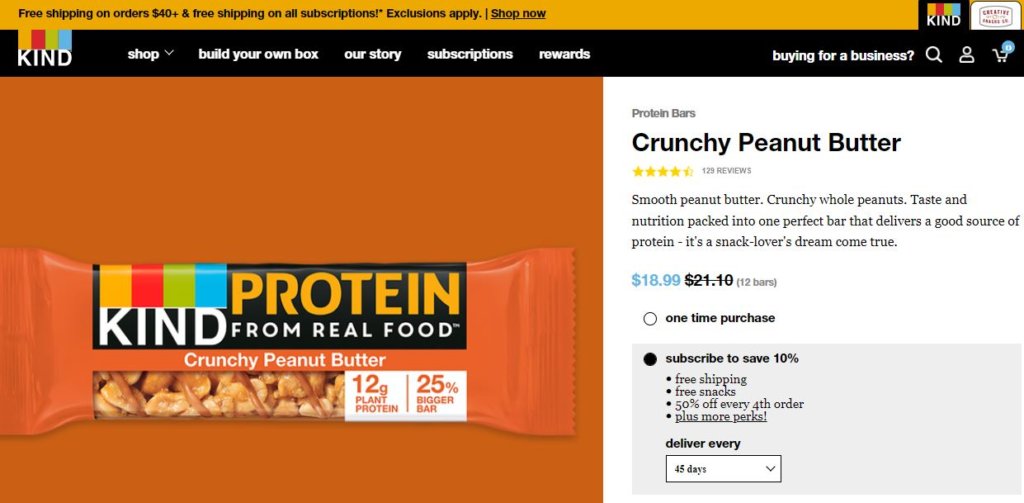
Image source. KIND Snacks’s product page subscription enrollment.
To encourage retention, they give subscribers 50% off every fourth shipment. For subscribers who last that long, they give KIND time to gather data that leads to more personalized offers and retention beyond four shipments.
3. Dollar Shave Club: Build an eCommerce community around content
Dollar Shave Club incorporates witty, sarcastic, but helpful content into their eCommerce experience. The point is to build community and enthusiasm around the mundane daily activity of shaving.
According to Parse.ly’s 2022 Content Matters Report, 83% of marketers use content to “retain and expand existing customers” or “drive traffic to products for sale.” Dollar Shave Club’s podcasts and blog posts can easily be consumed during the morning bathroom routine. And at the end of each post, a link to a related product appears.
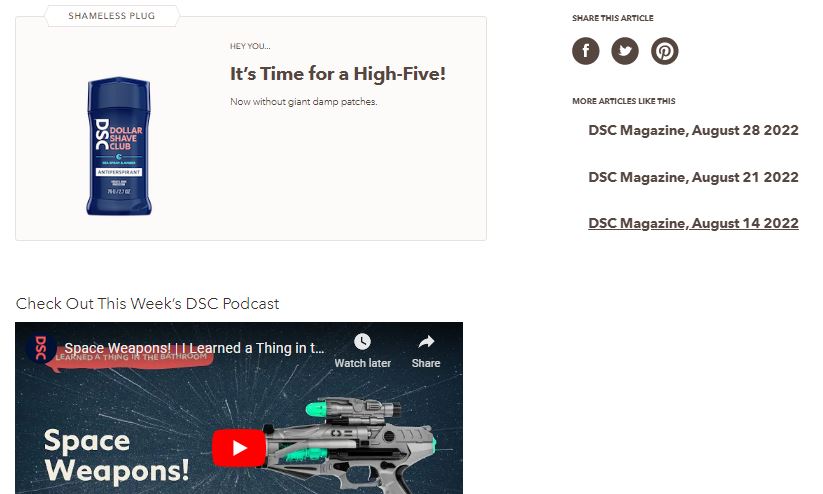
Image source. Dollar Shave Club’s weekly magazine product callout.
According to a Bloomberg report, Dollar Shave Club had the highest customer retention rate from Q1 2020 to Q3 2021 among their competitive set. Their subscription experience is certainly part of their success story, but their content can’t be ruled out as a cause.
D2C eCommerce is about experiences first, selling second
D2C is far from dead. But direct-to-consumer eCommerce businesses need to focus continually on making online shopping a better option. The only way to achieve this goal is to audit and optimize the eCommerce customer experience on a regular basis.
And if you follow the tips above, you’ll find that you don’t need to be online marketplaces like Amazon or Walmart to pull it off.
Get in touch now to learn how Ordergroove can help improve your D2C eCommerce store with subscription experiences.